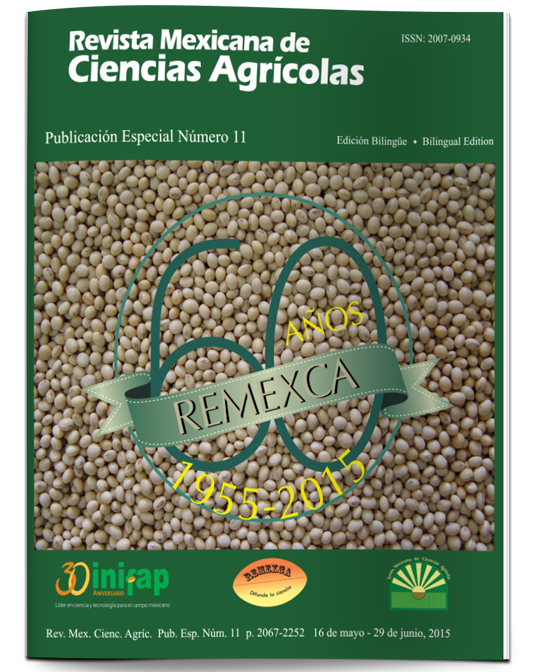Insectos plaga en cultivo asociado de Ricinus communis y Moringa oleifera en el centro de Veracruz, México
DOI:
https://doi.org/10.29312/remexca.v0i11.805Keywords:
Atta mexicana, Corythucha gossypii, Moringa oleifera, Ricinus communis, Sagotylus conf luens, Trichoplusia niAbstract
Moringa oleifera y Ricinus communis son considerados como cultivos de importancia comercial en el subtrópico mexicano. Sin embargo, dada su relativa novedad, su introducción podría enfrentar problemas con insectos plaga aún no documentados. Este estudio presenta un análisis de los principales insectos plaga observados en un cultivo asociado de R. communis y M. oleifera en la región central de Veracruz, México. Un total de 296 plantas se monitorearon desde su emergencia, hasta por un periodo de dos años (2012-2014), llevándose un registro de insectos plaga y sus efectos sobre las plantas. M. oleifera fue afectada solamente durante su etapa de plántula, principalmente por Atta Mexicana (Smith) (Hymenoptera: Formicidae) y Trichoplusia ni (Hübner) (Lepidoptera: Noctuidae), que no se observaron durante la etapa de madurez. R. communis fue severamente afectado por Sagotylus conf luens (Say) (Hemiptera: Coreidae) y por Corythucha gossypii (Fabricius) (Hemiptera: Tingidae), presente durante la fase de plántula y madurez. Mientras que S. conf luens fue estacional, C. gossypii se mantuvo durante todo el año y fue capaz de reducir la producción de semillas hasta en 90%. En el contexto de una plantación comercial, se recomienda el establecimiento de un programa de control de plagas durante la etapa juvenil de M. oleifera y durante todo el ciclo de vida de R. communis.
Downloads
Downloads
Published
How to Cite
Issue
Section
License
The authors who publish in Revista Mexicana de Ciencias Agrícolas accept the following conditions:
In accordance with copyright laws, Revista Mexicana de Ciencias Agrícolas recognizes and respects the authors’ moral right and ownership of property rights which will be transferred to the journal for dissemination in open access. Invariably, all the authors have to sign a letter of transfer of property rights and of originality of the article to Instituto Nacional de Investigaciones Forestales, Agrícolas y Pecuarias (INIFAP) [National Institute of Forestry, Agricultural and Livestock Research]. The author(s) must pay a fee for the reception of articles before proceeding to editorial review.
All the texts published by Revista Mexicana de Ciencias Agrícolas —with no exception— are distributed under a Creative Commons License Attribution-NonCommercial 4.0 International (CC BY-NC 4.0), which allows third parties to use the publication as long as the work’s authorship and its first publication in this journal are mentioned.
The author(s) can enter into independent and additional contractual agreements for the nonexclusive distribution of the version of the article published in Revista Mexicana de Ciencias Agrícolas (for example include it into an institutional repository or publish it in a book) as long as it is clearly and explicitly indicated that the work was published for the first time in Revista Mexicana de Ciencias Agrícolas.
For all the above, the authors shall send the Letter-transfer of Property Rights for the first publication duly filled in and signed by the author(s). This form must be sent as a PDF file to: revista_atm@yahoo.com.mx; cienciasagricola@inifap.gob.mx; remexca2017@gmail.
This work is licensed under a Creative Commons Attribution-Noncommercial 4.0 International license.



